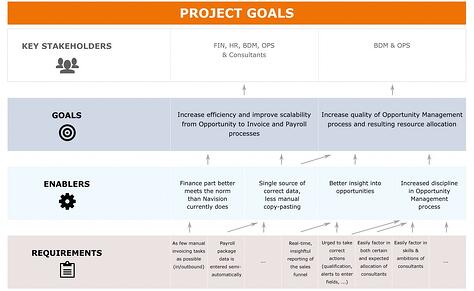
A common issue encountered on projects is that the project goals have not been clearly defined. A Benefit Map is a powerful visual to provide solace.
Have you had the impression that not every stakeholder has the same expectancies of a project? That too much time is being spent on matters that are not all that important? That not everyone understands why a project even exists in the first place?
A Benefit Map can help you provide a clear visual answer to all of these concerns. In this post, I will explain just what a Benefit Map is exactly and why it’s effective, and I’ll show you how we’ve applied the technique here at AE as part of a software package implementation.
What is a Benefit Map?
A Benefit Map is a visual representation of your project’s goals and the way you assume those goals will be reached. A Benefit Map contains different levels. It can be applied in various forms in which various levels can be left out or renamed.
At AE, we are currently implementing an integrated ERP package to support the processes in BDM, OPS, Finance and HR. The Benefit Map for this project is a crucial visual piece to the puzzle and consists of three levels: Goals, Enablers and Requirements.
The Benefit Map is a deceivably simple figure, not in the least because the process behind its creation (and digging up the required information) should not be underestimated. For one, your stakeholders can’t just pull such a complete overview right out of their hats. People also often confuse goals with ways to achieve them, which means the actual goal to reach still needs to be formulated.
Elements such as ‘we need a better view on available opportunities’ or ‘the data in our payroll package has to be entered semi-automatically’ were important in the package implementation process here at AE, but neither are goals by themselves. They’re examples of an ‘enabler’ and a ‘requirement’ respectively: they will help to achieve the underlying goals.
Creating a Benefit Map helps to clearly delineate what’s what.
Benefit Map benefits
A very big advantage of a Benefit Map is that it helps to clearly formulate your goals. Because of its visual nature, it’s quite easy to trace back all of the actions leading up to a particular goal.
It’s important that assumptions (the arrows on the Benefit Map pictured above) are made explicit and that they can be challenged. When you’re in doubt about an assumption, you should verify it through prototyping, a survey, a demo …
Another advantage of a Benefit Map is that it presents what your project goals are and how you’ll achieve them in a single visual to all stakeholders.
Hence, it’s easier to set priorities and pointless discussions about aspects that do not add to the main goals can be avoided. Should a stakeholder follow his own agenda on a project, you can always refer to the Benefit Map to get everyone on the same page again.
As mentioned earlier: there are several variations on the Benefit Map concept. My colleague Stefaan Bergmans has also written an interesting article in line with this topic: his thoughts on bridging the gap between business and strategy through Value Driven Transformation go hand in hand with the advantages a Benefit Map presents.
Contact us if you want to know more about how to apply the Benefit Map technique in your project.








